2019_2020学年高中英语module6animalsindanger课时跟踪检测一含解析外研版必修5
- 格式:doc
- 大小:532.50 KB
- 文档页数:6
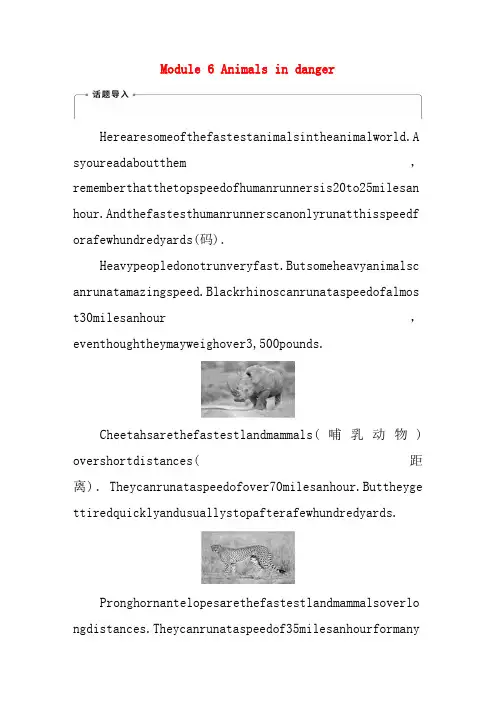
Module 6 Animals in dangerHerearesomeofthefastestanimalsintheanimalworld.A syoureadaboutthem,rememberthatthetopspeedofhumanrunnersis20to25milesan hour.Andthefastesthumanrunnerscanonlyrunatthisspeedf orafewhundredyards(码).Heavypeopledonotrunveryfast.Butsomeheavyanimalsc anrunatamazingspeed.Blackrhinoscanrunataspeedofalmos t30milesanhour,eventhoughtheymayweighover3,500pounds.Cheetahsarethefastestlandmammals(哺乳动物) overshortdistances(距离).Theycanrunataspeedofover70milesanhour.Buttheyge ttiredquicklyandusuallystopafterafewhundredyards.Pronghornantelopesarethefastestlandmammalsoverlo ngdistances.Theycanrunataspeedof35milesanhourformanymiles.Theirtopspeedisprobablymorethan50milesanhour.Hummingbirdsarethesmallestbirds.Buttheymovetheir wings(翅膀) fasterthanotherbirds.Someofthembeattheirwings4,500ti mesaminute.Ostrichescan’tfly,buttheycanrunfasterthanotherbirdsandmostotheranimals aswell.Theycanrunatatopspeedof43milesanhourforashort distance,butcankeepupaspeedofmorethan30milesanhouroverlongdis tances.Theyarealsothelargestofallbirds,andtheylaythelargesteggs.阅读短文,选择正确答案1.Whatarethefastestlandmammalsovershortdistances?A.Cheetahs. B.Pronghornantelopes. C.Horses. D.Elephants.答案 A 2.Thetopspeedofpronghornantelopesmaybeovermilesanho ur.A.20B.30C.35D.50答案 D 3.Ostrichescanrunmorethanmilesanhouroverlongdistanc es.A.50B.43C.35D.30答案 DPeriodOne Introduction&Reading—Prereading匹配左边的单词与右边的汉语意思[第一组]1.endanger A.n.栖息地2.reserve B.n.挣扎;斗争3.habitat C.adj.灭绝的;绝种的4.extinct D.vt.危及;使……处于险境5.struggle E.n.保护区;保护圈答案 1.D 2.E 3.A 4.C 5.B[第二组]6.wildlife A.n.(藏)羚羊7.protect B.n.野生生物8.poacher C.n.战斗9.antelope D.n.盗猎者;偷猎者10.battle E.vt.保护答案 6.B 7.E 8.D 9.A 10.C[第三组]11.plateau A.adj.值……钱12.ideal B.n.牧群;兽群13.shawl C.n.高原14.herd D.n.披肩15.worth E.adj.理想的答案11.C 12.E 13.D 14.B 15.A[第四组]16.skin A.n.&vt.(警方的)突击搜查17.spot B.n.环境;情况18.raid C.vt.没收19.confiscate D.vt.剥皮;去皮20.condition E.n.(某事发生的)准确地点;现场21.meanwhile F.n.(尤指买卖贵重商品的)商人22.dealer G.adv.同时答案16.D 17.E 18.A 19.C 20.B 21.G 22.FStep1FastreadingTrue(T)orFalse(F).1.Onacoldday,JiesangSuonandajiewaslookingforagroupoflosttourists. ( F ) 2.Alargenumberofantelopeshavebeenkilledfortheirmeat .( F ) 3.Shawlsmadefromtheantelopewoolcameintofashioninthe 1980s.( F ) 4.Littleprogresshasbeenmadeinprotectingtheantelopes .( F )5.Internationalcooperationonprotectingantelope sisa lsoprogressing.( T )Step2Carefulreading Choosethebestansweraccordingtothepassage. 1.WhywasJiesanglookingforthepoachers? A.Tofightwiththem.B.Tojointheminhunting. C.Tostopthemfromkillingtheantelopes.D.Toaskthemtohunt.答案 C2.Thepoachersweresurprisedat.A.Jiesang’sordertoaskthemtoputdowntheirguns B.Jiesang’squickmovementC.Jiesang’sbraveryD.beingfoundbyJiesang答案 C 3.Thequickdecreaseoftheantelopesisdueto. A.thefreezingandbadlivingconditions B.theirexpensivewoolC.theillegalexportoftheshawls D.thekillingfromthepoachers答案 D 4.WhathastheChinesegovernmentdonetoprotecttheantelo pesinthepastyears? A.Thegovernmenthaspassedlawstobanthetradeofthewoolf romtheantelopes. B.Thegovernmenthassetupnaturereserves. C.Thegovernmenthascaughtthepoachersandconfiscatedth eirvehicles.D.Alloftheabove.答案 D 5.WhichofthefollowingstatementsisNOTthereasonforthe increaseoftheantelopes? A.TheChinesegovernmenthaswonthebattleagainstthepoac hers. B.TheChinesegovernmenthastakenanactivepartinprotect ingtheantelopes. C.Manyvolunteerscomefromalloverthecountrytohelp. D.Thecooperationbetweenthecountries.答案 AStep3PostreadingAfterreadingthepassage,pleasefillinthefollowingblanks.1.OnafreezingcolddayinJanuary1994,JiesangSuonandajiefound2.whathewaslookingfor—agroup ofpoacherswhowerekillingtheendangeredTibetanantelope .Inthefollowingbattle,he3.wasshot(shoot) andkilled.Hehadgiven4.his(he) lifetosavetheTibetanantelope.Bythe1990sthenumberofth eTibetanantelopes5.hadfallen(fall)toabout50,000.Thereasonis6.thatthewooloftheTibetanan telopeisthemostexpensiveintheworld.Oftenworkingatnight,thepoachersshootwholeherdsofantelopesatatime,7.leavi ng(leave) onlythebabies,whosewoolisnotworthsomuch.Theanimalsareskinnedonthes potandthewoolistakentoIndia8.tomake(make)shawls.TheshawlsareexportedtorichcountriesinNorthAme ricaandEurope.Inthe1990stheChinesegovernmentbegantot ake9.anactivepartinprotectingtheantelopes.Since1997t heantelopepopulationhas10.slowly(slow) beguntogrowagain.Step4Sentencelearning1.Oftenworkingatnight,thepoachersshootwholeherdsofantelopesatatime,leavingonlythebabies,whosewoolisnotworthsomuch. [句式分析] 本句是一个复合句。
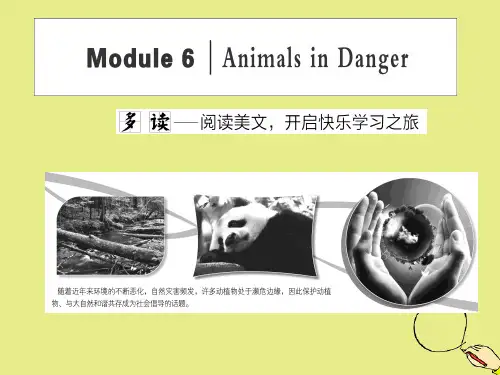
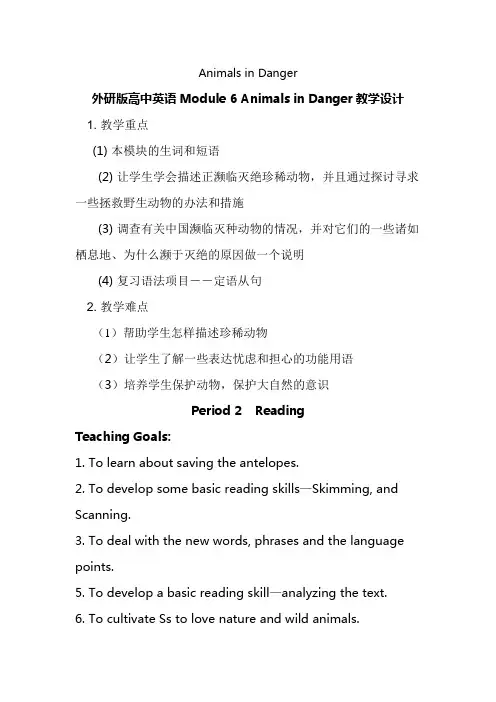
Animals in Danger外研版高中英语Module 6 Animals in Danger教学设计1. 教学重点(1) 本模块的生词和短语(2) 让学生学会描述正濒临灭绝珍稀动物,并且通过探讨寻求一些拯救野生动物的办法和措施(3) 调查有关中国濒临灭种动物的情况,并对它们的一些诸如栖息地、为什么濒于灭绝的原因做一个说明(4) 复习语法项目――定语从句2. 教学难点(1)帮助学生怎样描述珍稀动物(2)让学生了解一些表达忧虑和担心的功能用语(3)培养学生保护动物,保护大自然的意识Period 2 ReadingTeaching Goals:1. To learn about saving the antelopes.2. To develop some basic reading skills—Skimming, and Scanning.3. To deal with the new words, phrases and the language points.5. To develop a basic reading skill—analyzing the text.6. To cultivate Ss to love nature and wild animals.Teaching Procedures:Step 1 Lead inPurpose: To arouse Ss’interest in learning about saving the endangered animals.Show some pictures about the endangered animals and lead to the content of reading.Step 2 ScanningPurpose: To get the general idea of the passage.Scan the passage and get what the passage is about. (The passage is about saving the Tibetan antelope from poaching.)After that, ask Ss to work in pairs and try to analyze the main idea of each paragraph. Several minutes later, ask some students to show their opinions.Suggested answers:Paragraph 1: Jiesang Suonandajie gave his life to save the Tibetan antelope.Paragraph 2: A large number of antelopes have been killed for their wool.Paragraph 3: The business of antelope wool is illegal but it is not easy to be stopped.Paragraph 4: The Chinese government began to take an active part in protecting the antelopes.Paragraph 5: Progress has been made in protecting the antelopes.Step 3 SkimmingPurpose: To get some details in the passage.Ask Ss to read the passage again, and finish Activity 2&3.Suggested answers of Activity 2:1(b) 2(b) 3(a) 4(c) 5(a)Suggested answers of Activity 3:1 The number of antelopes left by the 1990s.2 The price of a shawl made from “shatoosh”.3 The year when the trade ban on “shatoosh”.4 The number of “shatoosh”shawls found in a London shop.5 The percentage of the antelope population those shawls represented.6 The number of poachers caught in ten years.7 The height of the Qinghai-Tibetan Plateau.8 The year when the antelope population started to grow again.Step 4 New words studyingPurpose: To deal with the new words and phrases in the passage.Ask the Ss to finish Activity 4.Suggested answers:1 plateau2 shawl3 profit4 herd5 skin6 ban7 raid8 confiscated9 tough 10co-operationStep 5 Careful readingPurpose:To train Ss’listening ability and to deal with the language points in the text.Listen to the tape and follow it in a low voice. Then the students are divided into five groups. Each group is supposed to read through each paragraph, and then share the points.Paragraph 11. On a freezing cold day in January 1994, JiesangSuonandajie found what he was looking for — a group of poachers who were killing the endangered Tibetanantelope.1994年1月一个滴水成冰的寒冷日子,杰桑·索南达杰发现了他一直在寻找的目标——正在猎杀濒临灭绝的藏羚羊的一群偷猎者。

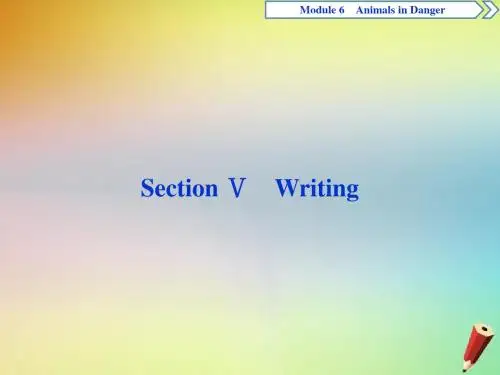
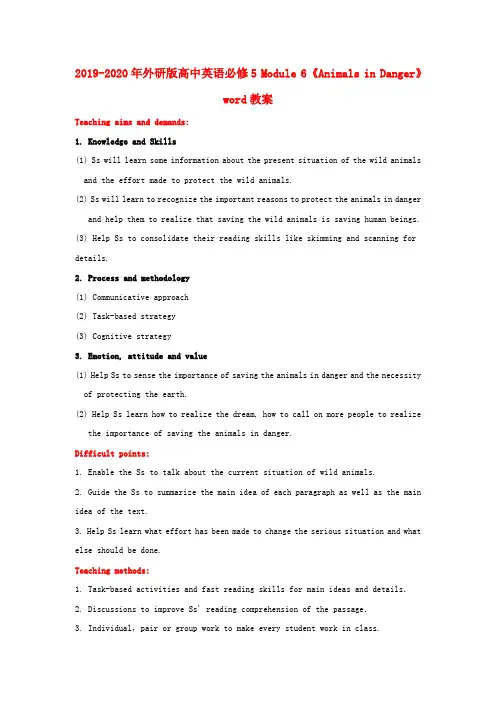
2019-2020年外研版高中英语必修5 Module 6《Animals in Danger》word教案Teaching aims and demands:1. Knowledge and Skills(1) Ss will learn some information about the present situation of the wild animals and the effort made to protect the wild animals.(2) Ss will learn to recognize the important reasons to protect the animals in dangerand help them to realize that saving the wild animals is saving human beings.(3) Help Ss to consolidate their reading skills like skimming and scanning for details.2. Process and methodology(1) Communicative approach(2) Task-based strategy(3) Cognitive strategy3. Emotion, attitude and value(1) Help Ss to sense the importance of saving the animals in danger and the necessity of protecting the earth.(2) Help Ss learn how to realize the dream, how to call on more people to realizethe importance of saving the animals in danger.Difficult points:1. Enable the Ss to talk about the current situation of wild animals.2. Guide the Ss to summarize the main idea of each paragraph as well as the main idea of the text.3. Help Ss learn what effort has been made to change the serious situation and what else should be done.Teaching methods:1. Task-based activities and fast reading skills for main ideas and details.2. Discussions to improve Ss' reading comprehension of the passage.3. Individual,pair or group work to make every student work in class.Teaching aids:Computer, tape recorder, and blackboard and papers.Teaching procedures:Step 1. Greetings. Greet the whole class as usual.Step 2. Warming up.Begin with several pictures of dinosaurs, which will help the Ss to realize the topic of this module. And talk about several pictures with 2 questions:1.What do the giant panda and Siberian tiger have in common?2.What can we do to help them in their struggle for survival?Step 3. PresentationWith the help of several pictures and a flash, let the students predict the text. Step 4. Reading.1. Fast reading: help the Ss get some general information of the passage.A. Who is Jiesang Suonandajie?B. Why do the poachers kill the antelopes?2. Careful reading: Summarize the general idea of the whole passage.Para. 1 Jiesang Suonandajie died when protecting antelopes.Para. 2 The reason for the trade.Para. 3 The process of the trade.Para. 4 The result of the battle.Para. 5 The present situation and the future of the battle.3. Listen to the tape to catch specific information of the passage and ask the Ss to fill in the blanks.The general idea of the text:The reading gives a brief description of the current situation of antelopes. Realize the importance and urgency of protecting the wild animals. The struggle of protecting antelopes will last a long time and will call on more and more people to take part in it.Step 5. Reading for details and comprehension.Complete the table2. Finish exercise2 on Page 52.Step 6. Discussions:let the Ss realize the purpose of learning this passage, the importance of saving antelopes and the necessity of taking immediate measures. (a flash 藏羚羊的心愿 will help the Ss fully understand the topic.)1. What do you learn from the text?2. Why do we have to prevent the animals from dying out?3. In your opinion, what should we Chinese people do to save the endangered Tibetan antelope?Step 7. Collecting answers and making a summaryStep 8. HomeworkRead the text and underline the difficult sentences.Finish exercise 4 on Page53.Period TwoStep 1. Language points in introduction:1. Thanks to scientists’ hard work, the number of the pandas living in the wildhas increased to about 1,590.thanks to 多亏,由于 because of, as a result of,e.g. Thanks to the firefighters, people were saved in the fire.2. Every year thousands of wild animals and plants become extinct.extinct adj. (生物等)已灭绝,已绝种的This kind of elephant has been extinct for a long time.3. …More than 12,000 animal species are now in danger.in danger 在危险中,濒危e.g. This kind of tiger is in danger.He is in great danger of failing the entrance examination.Step 2. Language points in reading:4. On a freezing cold day in January 1994,…freezing adj. 极冷的, 冷淡的frozen adj. 被冰冻的, 结冰的,冷漠的freezing point, a freezing machine,frozen food, in frozen silence5. Although surprised, the poachers had an advantage—they were more of them.although surprised—although they were surprised at the shout6. He had given his life to save the Tibetan antelope.give one’ life to…为……献身, 把一生献给……7. The animals are skinned on the spot and the wool taken to India…on the spot当场,在现场, 立刻e.g. Anyone breaking the rules will be asked to leave on the spot.When the fighting started, policemen and reporters were soon on the spot.8. But in the 1990s the shawls came into fashion among rich people.come into fashion 成为时尚9. The small group of officials who work in the reserve are helped by volunteers who come from all over the country, and who are ready for the difficult conditionsof life at 5,000 metres.此句包含了三个由who 引导的定语从句(让学生体会定语从句在高考中的考察)10. Meanwhile, in those countries where the shawls are sold, police are getting tough with the dealers.get/ be tough with sb. 对某人强硬起来, 对某人毫不妥协e.g. The government will get tough with the people who avoid paying taxes.11. be / feel concerned about/ for / over sth. 关心, 担心某事,对某事关注12. important phrases:keep an eye on 照看go for someone 向某人进攻on the brink of … 在……边缘stand for 代表have an effect on 对……有影响Step 3. Homework1. Review what we have learnt.2. Remember the new words and expressions.3. Finish exercises on P53.Period ThreeStep1. Grammar –1. Presentation.Look at the underlined clauses and find the function of the clauses.Step2. Grammar –2. Practice. (15m)Do exercises 2,3,4 and 5 in the textbook.Step3. Grammar –3. Conclusion (15m)Ask Ss to make a conclusion of the use of attributive clauses. Two kinds of the attributive clause:1. 限制性定语从句restrictive attributive clause(无逗号)2. 非限制性定语从句non- restrictive attributive clause(有逗号)He doesn’t like to wear clothes which/that made him very strange.He doesn’t like to wear clothes ,which made him very strange.Xi hua who I met across in the street a few days ago has gone abroad.Xi hua ,who I met across in the street a few days ago has gone abroad. Attributive clause:定语从句被修饰的词:先行词引导定语从句的词:关系词关系词分为关系代词和关系副词两类,指代被修饰的词(先行词),并且在从句中充当成分. They have three houses. + The three houses are built of stone.===They have three houses which/that are built of stone.He is not a true man. + He doesn’t reach the Great Wall ====He who doesn’t reach the Great Wall is not a true man.Step 4. Function – 1. PresentationGive some facts and show your concern.✧Today there are only about 1,000 Siberian tigers left.✧It is reported that there are only 200-300 Northern bald ibises left.✧It is said that 12,000 animal species are now in danger.What do you feel when you read this?Step 5. Function – 2. PracticePoint out the expressions of concern.It is really upsetting.I’m very worried about…I’m concerned about…We really should do more for…Make more sentences to show your concern to the animals in danger.Step 6. Homework - Task of the lesson1.Have a revision of the grammar—the attributive clauses .2.Finish the exercises of workbook on page97Period FourTeaching aims:1. Target languagea. 重点词汇和短语 bird, insect, mammal, reptile, reserveb. 重点句子It’s a pity I didn’t have my camera! P562. Ability aimsGet the Ss to tell apart birds, insects, mammals and reptiles.3. Learning abilityGet the Ss to learn how to get the main information by writing down “key words”. Important & difficult points:Get the Ss to learn how to get the main inf ormation by writing down “key words”. Teaching methods:Practising, sorting and listening.Teaching aids:A computer, a projector and a tape-recorder.Teaching procedures:Step 1. Greeting and revisionT: There are more than ten English teachers a ttending to our class. Let’s welcome them. OK, class begins. Good morning!Ss: Good morning!Go through the teaching procedures, then make a revision by practicing the language focuses.T: Last lesson, we have practiced how to get main information by “key words”on reading. Here are four short passages at the bottom of page 55. Please read them as quickly as you can, then match the description with the photos.Half a minute later, check the answers and summary the means of getting main information by key words.Step 2. VocabularyGuide the Ss to do Activities 1 and 3. Get them to guess the animals on the screen and sort them.T: But who can tell us the differences between birds, insects, mammals and reptiles?Show the exercises of Activity 1 on the screen and ask individual to do the answers. S1: A bird has warm blood and lays eggs.S2: An insect is a small animal with six legs. Some have wings.S3: A reptiles has cold blood and lays eggs.S4: A mammal is an animal which drinks its mother’s mil k when it is young. T: You are completely right! Now, please turn to Page 56 and do Activity 3 according to the instruction. I will show you some photos of animals. You should tell me their names and fill in the table.Show some photos of animals on the screen and check whether the Ss tell their names rightly. Then, show one student’s answers on the screen to check with the whole class.Step 3. ListeningT: Now, please look at the picture on the screen. What is the continent?Ss: Africa.T: Yes. Pay attention to the south. There is a nature reserve. What’s its name? Ss: Tembe Elephant Reserve.T: Well, just now, we have talked about some animals. If you were a volunteer there, which animals would you talk about? Why?Ss: Elephant. Because the name of the reserve tells us. And the elephant is the most famous and useful animal in South Africa.T: You are quite right. Now go through the questions on the screen. Try you bestto get the useful information for listening, at the same time, you should focus on what information you have to get while listening. I’ll give you two minutes.1.What was William Norris?2.Where was he work in?3.How long was he there?4.How many elephants are there in the reserve?5.Which animals did he work with?6.How often did he see them?7.Does William think people can help animals in danger?Two minutes later, Get the Ss to listen to the tape carefully and try to write down the “key words” for answering the questions.T: Are you ready?Ss: Yes.T: Now, listen to the tape carefully and try to write down the “key words” for answering the questions.Ss: OK.T: Have you got the answers?Ss: Yes.T: Good! Who wants to tell us your answers?S1: He was a volunteer.S2: On the Theme Nature Reserve in South Africa.S3: Only three months.S4: About 250.S5: Lions.S6: Almost every night.S7: Yes, he does.T: Well d one! Now listen again and complete the page from William’s diary in Activity 6.Then check the answers and summery the skills of listening.Step 4. HomeworkDo pair works to describe an animal in Activity 3 after class. One describes an animal and the other tries to guess what it is. Then make a change.Period FiveStep 1. Read the form and find out what animals they are.Step 2. Read the form and ask and answer.Talk about these animals and find more information.Ss may do like this:A: What kind of animal is the Siberian tiger?B: It is the largest member of cat family.A: Where can Siberian tigers be found?B: It can be found in Siberia of Russia and parts of Northeast China.… …Step 3. Cultural Corner –Prediction Look at the title and the pictures and predict the answers.1. What does WWF stand for?2. What kind of work does WWF do?Step 4. Read the passage and answer the questions.1. What’s the aim of the WWF when it was founded?2. Does the organization always have the same focus of attention?3. When did the WWF set up an office in Beijing?Step 5. Read again and decide the following statements are True or False.1. The WWF was founded in Switzerland in the year 1961.2. Peter Scott was both a painter and a naturalist.3. At present the organization has branches in 130 countries.4. The WWF only pays attention to protecting wild animals in danger.5. It was Dr George Shaller who set up an office of WWF in Beijing.6. Saving the panda is one of the projects that the WWF is carrying out in China. (Answers: 1—6 FTFFFT)Step 6. Ask Ss to do the role-play and give an interview.Four Ss a group to have an interview, talking about how to save the endangered animals.A: an official working for the branch of the WWF in ChinaB: a volunteer working for the WWFC: a reporter from CRID: a reporter from CCTVStep 7. Language points in cultural cornerStep 8. HomeworkWrite a passage of a certain kind of endangered animal, its description, habitat, numbers left and the way to save it must be included.。
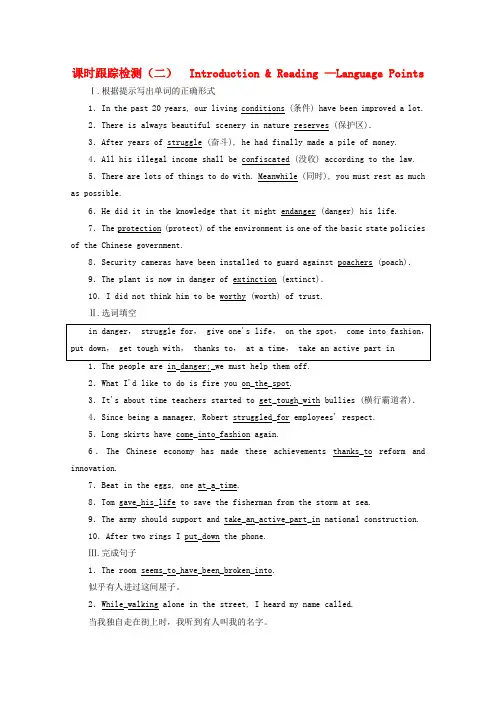
课时跟踪检测(二) Introduction & Reading —Language Points Ⅰ.根据提示写出单词的正确形式1.In the past 20 years, our living conditions (条件) have been improved a lot.2.There is always beautiful scenery in nature reserves (保护区).3.After years of struggle (奋斗), he had finally made a pile of money.4.All his illegal income shall be confiscated (没收) according to the law.5.There are lots of things to do with. Meanwhile (同时), you must rest as much as possible.6.He did it in the knowledge that it might endanger (danger) his life.7.The protection (protect) of the environment is one of the basic state policies of the Chinese government.8.Security cameras have been installed to guard against poachers (poach).9.The plant is now in danger of extinction (extinct).10.I did not think him to be worthy (worth) of trust.Ⅱ.选词填空The people are in_danger;_we must help them off.2.What I'd like to do is fire you on_the_spot.3.It's about time teachers started to get_tough_with bullies (横行霸道者).4.Since being a manager, Robert struggled_for employees' respect.5.Long skirts have come_into_fashion again.6.The Chinese economy has made these achievements thanks_to reform and innovation.7.Beat in the eggs, one at_a_time.8.Tom gave_his_life to save the fisherman from the storm at sea.9.The army should support and take_an_active_part_in national construction.10.After two rings I put_down the phone.Ⅲ.完成句子1.The room seems_to_have_been_broken_into.似乎有人进过这间屋子。
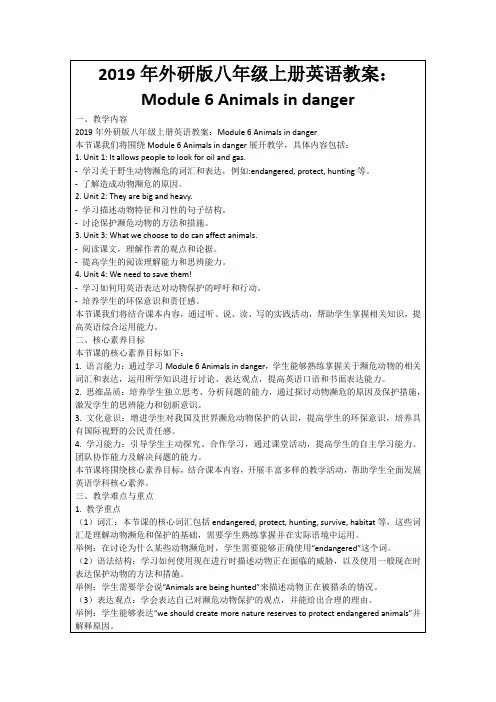
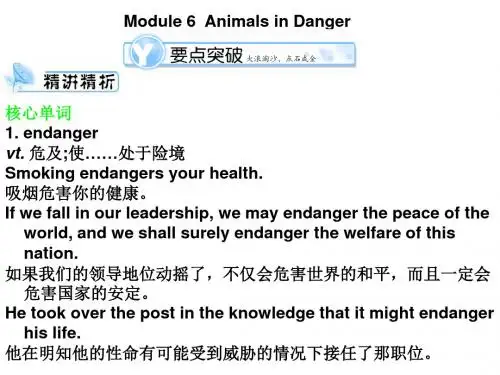
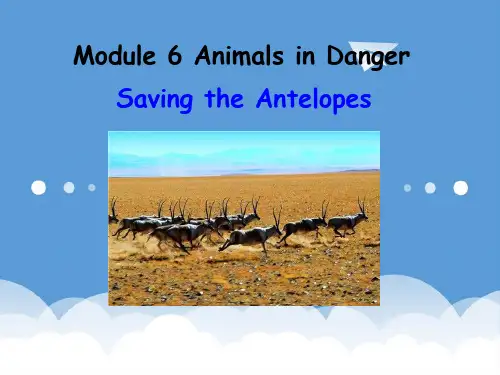
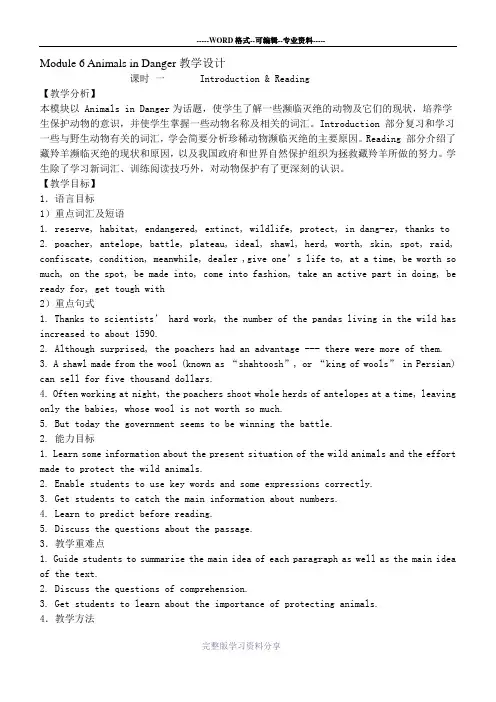
Module 6 Animals in Danger教学设计课时一 Introduction & Reading【教学分析】本模块以 Animals in Danger为话题,使学生了解一些濒临灭绝的动物及它们的现状,培养学生保护动物的意识,并使学生掌握一些动物名称及相关的词汇。
Introduction 部分复习和学习一些与野生动物有关的词汇,学会简要分析珍稀动物濒临灭绝的主要原因。
Reading 部分介绍了藏羚羊濒临灭绝的现状和原因,以及我国政府和世界自然保护组织为拯救藏羚羊所做的努力。
学生除了学习新词汇、训练阅读技巧外,对动物保护有了更深刻的认识。
【教学目标】1.语言目标1)重点词汇及短语1. reserve, habitat, endangered, extinct, wildlife, protect, in dang-er, thanks to2. poacher, antelope, battle, plateau, ideal, shawl, herd, worth, skin, spot, raid, confiscate, condition, meanwhile, dealer ,give one’s life to, at a time, be worth so much, on the spot, be made into, come into fashion, take an active part in doing, be ready for, get tough with2)重点句式1. Thanks to scientists’ hard work, the number of the panda s living in the wild has increased to about 1590.2. Although surprised, the poachers had an advantage --- there were more of them.3. A shawl made from the wool (known as “shahtoosh”, or “king of wools” in Persian) can sell for five thousand dollars.4. Often working at night, the poachers shoot whole herds of antelopes at a time, leaving only the babies, whose wool is not worth so much.5. But today the government seems to be winning the battle.2. 能力目标1. Learn some information about the present situation of the wild animals and the effort made to protect the wild animals.2. Enable students to use key words and some expressions correctly.3. Get students to catch the main information about numbers.4. Learn to predict before reading.5. Discuss the questions about the passage.3.教学重难点1. Guide students to summarize the main idea of each paragraph as well as the main idea of the text.2. Discuss the questions of comprehension.3. Get students to learn about the importance of protecting animals.4.教学方法1. Fast reading skills for main ideas and details.2. Discussions to improve students’ reading comprehension3. Individual, pair or group work to make every student work in class.【教学过程】I. Brainstorming (头脑风暴)以flash短片引入本节课的话题——拯救藏羚羊。
外研社高中英语必修五module 6 Animals in Danger 阅读板块教学设计课题名称:Reading:Saving the Antelopes课型:阅读课授课班级:xx南山实验高二15班授课教师:xx南山实验英语组秦锐授课时间:20xx年12月11日本课时教学内容为外研版新标准高中英语必修五module 6 Animals in Danger中的Reading,是该模块的第二课时,在单词和introduction的教学之后。
一.教材分析1.本模块的话题是保护濒危动物。
首先在“introduction〞中介绍了一些野生动物,也引入了与动物有关的词汇,为之后的学习做了铺垫。
本课时“Reading〞带着同学们了解保护藏羚羊的故事,保护的措施以及藏羚羊的现状,是同学们正确了解自然与人的关系,增强保护生态环境的意识,并从身边的小事做起,保护大自然,保护大自然。
二.设计思路和理论依据《普通高中英语课程标准〔实验〕》在“课程目标〞中指出:“高中英语课程应该强调再进一步开展学生综合语言能力的根底上,着重提高学生用英语获取信息、处理信息、分析问题和解决问题的能力,特别注重提高学生用英语进行思维的和表达的能力;形成跨文化交际的意识和能力。
〞本课堂希望做到知识和能力、情感态度和价值观、学生个性开展,教学和教育的四个统一。
三.教学目标1.知识目标了解许多珍稀动物正濒临灭绝这一严峻现实,帮助学生增强拯救野生动物、保护自然环境的意识对文章的整体框架,组织结构有清晰的认识2.技能目标能在阅读中通过语境识别新学词汇、短语并推断其意思能正确理解介绍藏羚羊或野生动物的短文能从文中提取和筛选信息并进行重组。
能运用新学和已学的词汇和知识进行表达和讨论。
3.情感态度与价值观了解本单元的总体学习目标,以激发学生的学习动力正确了解自然与人的关系,增强保护生态环境的意识,并从身边的小事做起,保护野生动物,保护大自然4.教学重点、难点:引导学生理解、提取、筛选、重组信息启发学生运用信息及语言点就“Saving the Antelopes〞进行有意义的语言输出四.教学步骤Step1. Lead-in (5 min)1.show students a video about Jiesang and antelopes2.ask students to guess what’s this picture about3.look at this picture and review wordsStep2. Fast reading (5 min)Ask students to read this passage and find out the main idea of each paragraph.Step3. Careful reading (17 min)1. Read paragraph 1 and think about what happened to Jiesang. (4 min)2. Read para2-3,do true or false questions and two multiple choices. (7 min)3. Read para4-5 and do the multiple choices. (6 min)Step4. Post reading〔3 min〕Ask students to answer these two questions according to the passage.Step5. Interview (10 min)Suppose you are a reporter and your partner is a poacher who was arrested by the police, you are interviewing him, and what questions do you want to ask? And what will you tell him? Now make a dialogue according to the passage.Step6. Homework (writing)。
Module 6 Animals in Danger 说课稿各位老师好,今天我为大家介绍必修五第六单元“Animals in Danger”n部分。
本单元的主题是野生动物保护。
随着经济的发展,环境问题越来越突出,人类与自然的和谐共处成为我们必须面对的问题。
作为中学生,了解野生动物保护知识,树立环保意识非常必要。
本单元围绕这一中心,设计了听、说、读、写活动。
Reading部分是整个单元的核心,也是上一课时Warming up的延续和升华。
在这个课时中,大部分的重要词汇和语法也会呈现出来。
本课的教学重点是帮助学生深入了解保护野生动物的重要性,思考动物保护的多种方式。
教学难点是训练学生获取信息、处理信息、分析思考和解决问题的能力,培养学生带着问题去阅读文章的惯。
语言知识目标:掌握重点词汇、短语及句型,熟练运用英语表达野生动物所面临的问题和解决方案。
语言技能目标:继续巩固速读、概括比较等阅读技能,理解文章,突破固有的思维模式,提出新观点。
情感态度目标:认识到野生动物保护和环境保护对人类生存和发展的非凡重要性,产生保护动物、保护大自然的使命感,热爱生命,关注自然,关注人与自然的和谐。
通过上一课时Warming up的研究,学生对于熊猫、华南虎等一些比较熟悉的濒危野生动物的现状已经有一定了解,也能举出许多濒危动物的名称。
但是他们还缺乏对相关词汇的研究和对国外濒危野生动物面临问题的了解。
另外,学生对于动物保护这个话题讨论的热情度不够,引导他们积极主动思考显得尤为重要。
因此,在处理这一堂课时,我会在指导学生快速阅读的同时引导学生相互合作,自己发现本单元重点语言结构,让学生自己发现并感悟相关的语言规律,培养他们的语感。
我会采用多种教学方法,包括问答活动、快速阅读活动、观看和听取活动、自由讨论方法、配对活动和角色扮演活动。
由于本文内容涉及大量图片信息,我将在多媒体教室上课,结合多媒体直观教学和传统教学方式,打造一堂趣味性和知识性相结合的阅读课。
课时跟踪检测(一) Introduction & Reading — Pre-reading 阅读理解A2013 was a recordbreaking year for rhinoceroses — but not in a good way. That year, a total of 1,004 rhinos were poached (illegally hunted) in South Africa, the country where almost all of the world's rhinos live. That's an increase of more than 50 percent from 2012 —when 668 rhinos were killed. It was also the most South African rhinos killed in one year.“The world's rhinos are facing great danger,” says Dr. Naomi Doak of TRAFFIC, a conservation group that works to stop the trafficking (buying and selling) of wildlife.The rise in poaching is due to an increasing demand for rhino horns in Asian countries such as Vietnam and China, where the horns are used as key ingredients in traditional Asian medi cines. Some people believe taking groundup rhino horn can help treat pain, fevers, and cancer (though these uses have not been medically proven to be effective). The demand is so great that rhino horns can sell for more than$30,000 a pound in Asia.Poaching has already had extremely serious results for rhinos. The Western black rhino became extinct in the last ten years. The Javan rhinoceros has almost completely disappeared from Vietnam, with fewer than 50 remaining. Now, African black rhinos and white rh inos are facing disaster. The black rhino is listed as “highly endangered” by the International Union for Conservation of Nature. Fewer than 5,000 exist. White rhinos are considered “near threatened”, with about 20,150 in the wild.Many nations are now taking steps to protect rhinos. The governments of several countries have signed agreements to fight rhino poaching by making the sale of rhino horns illegal, catching poachers and smugglers (走私者),and increasing public awareness about the problem.South Africa has signed agreements with Vietnam and China to fight wildlife trafficking between the countries. It is developing similar agreements with Mozambique,Thailand, Laos, and Cambodia.“These countries must join together if they hope to stop this stealing of southern Africa's natural heritage (遗产),”says Tom Milliken, TRAFFIC's rhinoexpert.“Rhinohorn trafficking represents a threat to the basic structure of society.”语篇解读:本文是说明文。
偷猎犀牛使得全世界的犀牛濒临灭绝,多国已采取措施保护犀牛。
1.Why was 2013 a recordbreaking year?A.More rhinos were trafficked than ever.B.The largest number of rhinos was killed.C.It saw the highest increase in rhino prices.D.The number of rhinos dropped to the lowest.解析:选B 细节理解题。
由第一段中的“a total of 1,004 rhinos were poached”和“It was also the most South African rhinos killed in one year”可知,2013年共有1 004头犀牛被偷猎,是南非最多犀牛被捕杀的一年。
2.Why do some Asians want to buy rhino horns?A.To seek pleasure.B.To do experiments.C.For health benefits.D.For personal collection.解析:选C 推理判断题。
由第三段中的“the horns are used as key ingredien ts in traditional Asian medicines”和“Some people believe taking groundup rhino horn can help treat pain, fevers, and cancer”可知,在一些亚洲国家,人们出高价来买犀牛角,因为他们认为吃犀牛角粉有利于健康。
3.What is the focus of Paragraph 4?A.The serious situation of rhinos.B.The importance of protecting rhinos.C.The measures taken to protect rhinos.D.The causes of rhinos' being endangered.解析:选A 段落大意题。
由第四段的描述可知,本段主要讲述了目前世界上犀牛的处境堪忧。
4.What does Tom Milliken think of rhino poaching?A.It endangers other wildlife.B.It is dangerous and damaging.C.It helps to develop the economy.D.It has been brought under control.解析:选B 推理判断题。
由最后一段中的“stop this stealing of southern Africa's natural heritage”和“Rhinohorn trafficking represents a threat to the basicstructure of society”可知,Tom Milliken 认为偷猎犀牛是对非洲南部自然遗产的偷窃,走私犀牛角是对社会基本结构的威胁。
B“Once there was the Stone Age, then the Bronze Age, and now we are in the middle of the Plastic Age,” said teenager Boyan Slat. “Every year, we produce 300 million tons of plastic. Much of it reaches our oceans.”At the age of 16, Boyan Slat scuba dived off Greece in the Mediterranean Sea seeing more rubbish floating on and under the surface. He said, “At first, I thought I was swimming through strange jellyfish. Instead, I swam through more plastic bags than fish.” Seeing all th e ocean trash, he asked himself,“Why not clean it up?”Slat quit his Aerospace Engineering studies to create www. theoceancleanup. com in order to fund his research on how to pick up all the plastic trash floating on the oceans of the world. Researchers discovered that 46, 000 pieces of plastic float on every square mile of the oceans, produced by billions of humans around the planet throwing their plastic into rivers, streams and directly into the oceans. What's worse, plastic does not break down.Today, we find plastic in the tissue of about every creature in the oceans. Additionally, millions of tons of plastic gather in giant oceangoing garbage patches (垃圾带). You may Google “The Great Pacific Garbage Patch”. It grows from 60 to 90 feet deep in places. It kills millions of sea birds, turtles, sharks, dolphins and whales.Being a brilliant, innocent teenager, Boyan Slat decided to construct designs of some equipment that would collect millions of tons of plastic floating on our oceans. He created a solarpowered trawler (拖网渔船) to pick up surface plastic, chew it up and store it in huge bins for collection. He also created floating booms (挡栅) that allow the oceans to sweep the plastic for efficient pickup. When you see the designs, they will blow your mind.Boyan Slat stands at the head of his class in creating solutions for the folly of humans. If ever humans need leaders to stand up and be counted, we need more people like Boyan Slat to lead us out of damaging our planet home towards a biologically healthy future.语篇解读:16岁的Boyan Slat设计出了专门用于收集海洋塑料垃圾的设备,为保护海洋生态系统作出了杰出的贡献。